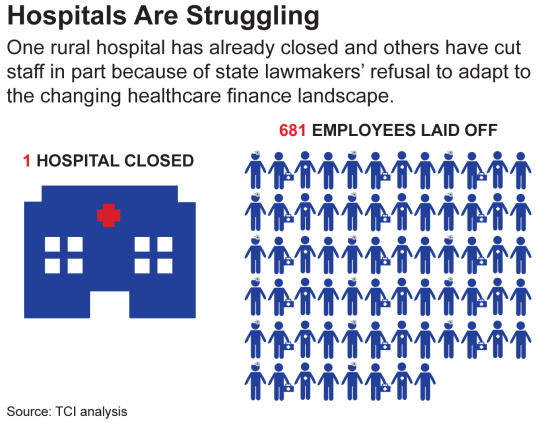September 29, 2015
In Rural Areas, Health Care Is at Risk
The 400,000 low-income, uninsured Virginians aren’t the only ones struggling to get by because state lawmakers haven’t closed the coverage gap. At least half of rural hospitals, and maybe more than that, were in the red last year, according to the Virginia Hospital and Health Care association and confirmed by PolitiFact Virginia.
With so many hospitals struggling, there are bound to be consequences. And there have been.
Back in 2013, Lee Regional Medical Center closed its doors in part because state lawmakers refused to adapt to the changing health care landscape where more people are supposed to have insurance to pay for the care they receive. The closing of Lee Regional hurt the local community and economy. It wiped out 140 good paying jobs. It also left an entire county without a hospital, drastically increasing the drive time for people needing emergency treatment. And it’s not as if Lee County is an area flush with physicians and alternative health care options: many uninsured folks from out that way rely on a once-a-year clinic that sets up camp at the regional airport and the occasional visit from a retrofitted RV. In fact, Lee is in the same neck of the woods as Grundy, which has the terrible monicker of Sickest Town in America.
While other hospitals have been able to keep their doors open, some have had to cut staff and services. At least 540 more jobs have been lost as hospitals across the state reduced their staffing levels, and that doesn’t include the hundreds of other employees who had their hours or wages cut.

Making matters worse, people who live outside of metropolitan areas in Virginia – like Lee County – are 19 percent more likely to be uninsured than their more urban counterparts. In total, 12.7 percent of people who live in more rural areas are uninsured, compared with just 10.7 percent in metropolitan areas. And when you have lots of people who can’t afford health insurance, you most likely also have lots of people who can’t afford costly, unexpected medical bills.
Struggling rural hospitals would be better off if more of their customers had insurance to help pay for the care they receive. One way to help fix that problem is to close the coverage gap, which could help as many as 400,000 low-income, uninsured Virginians get the care they need and make sure hospitals get paid for the services they provide. Had state lawmakers agreed to help them when they first had the chance in 2014, more than $2.8 billion dollars would have been pumped into our economy, largely through our hospitals.
One thing is for sure – the status quo is not sustainable. Rural hospitals and low-income, uninsured folks who are struggling to make ends meet can’t foot all of the bill. State lawmakers have a way to help, but they have to act.
–Massey Whorley, Senior Policy Analyst
